Journal of Plant Biochemistry & Physiology
Open Access
ISSN: 2329-9029
ISSN: 2329-9029
Research Article - (2023)Volume 11, Issue 3
Since, the inception of breeding research on sunflower inbred lines, genotype by environment interaction remain the main imbroglio. To overcome this problem, local hybrids have been developed through novel cytoplasm male sterile line (A, B and R lines) system; their selections were based on evaluation of Genotype × Environment interaction (G × E) in multi environmental trials. Thus, in the present study, 10 sunflower hybrids were evaluated for grain yield in three consecutive years 2015, 2016 and 2017 in replicated trials, in order to elucidate diverse genotypes against that particular environment. Among these hybrids NARC-229 had maximum yield (4.78 tons ha-1) followed by this ORI-114 (4.26 tons ha-1) across all environments. ANOVA of mean data expose (20%) of total variability in sunflower grain yield was contributed by that variable agro ecological zone, while year-on-year variation accounted for (13%) variation in the grain yield. Univariate stability indices i.e., CVi (%), bi, βi, and mean absolute rank differences S1 and S2 revealed that hybrid ORI-119, ORI-117 and NARC-225 were stable with consisted seed yield across different environments. Result of the analysis depicted that genotype 0RI-117 was only adoptable, while, genotypes NARC-225 and ORI-116 were stable to wide range of environments. Therefore, environment specific cultivation of suitable genotypes is recommended for higher yield.
Sunflower hybrids; Temporal climate; Genotype environment interaction, GGE biplot; Stability analysis
The common sunflower (Helianthus annuus L.) is an ancient species that belong to Asteraceae (compositae) family, having diploid chromosome number (2n=34), evolved through phenomena of polyploidy which lead towards genetic diversity. Botanically, sunflower is naturally out crossed and self-incompatible, in response which out cross freely with its wild ancestors. Therefore, Helianthus genus comprised of total 65 different species among 14 are perennial and belong to center origin of interior midlatitudes of eastern North America, Canada, and Mexico. Sunflower is a significant crop, containing 35%-55% oil content and 15%-21% protein and holds second position in the world in edible oil manufacturing following soybean oil [1-2]. The sunflower seed contains approximately 584 calories per 100 gram, although used as a snack, salad garnish, and in some bakery goods, such as mixing of sunflower seed with rye seed to form bread. While in Ukraine, highest cultivated area is 6,200 thousand hectare, having production 16,000 thousand metric tons. In Pakistan total cultivated area is 120 thousand hectare and production is 145 thousand metric tons (agriculture statistics of USDA). In Pakistan, sunflower was first introduced by oil and Ghee corporation as an oilseed crop in the 1960’s. However, edible oil is the essential component of our food but we are producing only 20% of our need and remaining 80% is imported which need exorbitant research to reduce this huge gap. Since, the inception of sunflower breeding program, hybrid development is remaining the prime objective of breeders because having high hybrid vigor and vigilant agronomic performance particularly in diverse agro-ecological zones of Pakistan [3]. Sunflower have enormous genetic potential to elevate its productivity focusing on abiotic and biotic stresses, greatest yield and oil percent losses occurs due to water deficit at flowering period. Acclimatization of sunflower in dry region is better than other crops due to its deeper root system, to extract water from deeper soil layers under water stress. Improving seed yield and oil quality, introgression of fungus resistance, drought resistance and quality enhancement are some of the key objectives of sunflower breeding. Similarly, in Pakistan, sunflower is cultivated in both rain-fed and irrigated areas [4]. However, in arid zone, low cultivation areas were observed because its vulnerable response towards drought stress as consequences decreases in overall production of sunflower. Therefore, not only considering the genetic potential of sunflower, but also immense study about interaction of genotypes to its environment (G × E) is necessary. Since, the inception of sunflower breeding research in Pakistan, studies on environment is negligible. Apart from the abiotic and biotic stresses, there is a decline in the cultivated and production area was observed due to unavailability of suitable hybrids for that particular environment. Considering all climatic features is a key to success, however, the sudden change in patterns of precipitation is one of the main constrain in unstable yield of sunflower all over the country [5].
This further intensified that advent of new sunflower hybrids of stable yield across wide range of environments important. Although, research oriented knowledge regarding genotype × environment interaction is crucial for breeders to mitigate undesirable effects of divers’ agro-climatic conditions and simultaneously exaggerate further efficiency of breeding program. Hybrids responsiveness to various environments stimuli prompts breeders not to rely solely on yield as selection criterion, but also includes stability analysis of hybrids genotypes over multiple environments. Due to all such problems breeders have given more importance to genotype × environment (drought and salinity levels) interactions in the crop breeding research. In Pakistan, varying agro-climatic (high mountainous valleys, semi irrigated and irrigated plains) distribution therefore, relative performance of different genotypes changes in different environments when there is a genotype × environment interaction. In other words, large genotype-environment interactions will effectively reduce progress from selection because worth of the genotypes/lines with improved quantitative characters like yield, oil and protein % depend to a considerable extent, on their repeatability in performance when they are grown over varied environments. This is one of the major challenges being faced by plant breeders today and to mitigate it a study on genotype by environment is compulsory [6].
Plant materials and field evaluation
Ten sunflower local hybrids, already developed through novel cytoplasm male sterile line system were evaluated by using randomized complete block design with three replication in three consecutive multiple environments at Oilseed Research Program (OSRP), National Agriculture Research Center (NARC), and Islamabad. In all environments, optimal agro-technical practices for sunflower were applied. Table 2 shows detail information all environmental factors. Each experimental plot for sunflower hybrid composed of four rows having five meter length with 75 cm and 45 cm between and within rows, respectively. Plants of each plot were harvested at physiological maturity and then the seed yield was recorded for sunflower hybrids at each test environment. Seed yield expressed in kg ha-1 and adjusted to 11% moisture was recorded by first harvested and threshed manually of two central rows of plot to avoid edge effect and then converted plot yield into kilo gram per hectare [7].
Study area
The study area, national agriculture research center Islamabad is located between 33°2801200N latitude and 72°4803600E longitude in according to the United Nations world urbanization prospects. Islamabad is sub-humid and hot area where moisture content is abundant for sunflower growing (Figure 1).
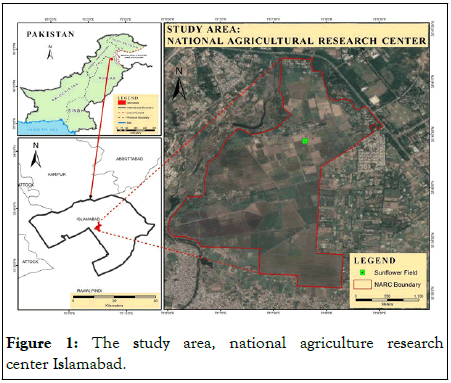
Figure 1: The study area, national agriculture research center Islamabad.
Statistical analysis
Data from respective environments were first interpreted separately and then the combined analysis of variance for grain yield was performed in order to determine the effect of genotypes by environment interaction (G × E). The combined analysis of variance was carried out with “genotype” as the fixed effect and “environment” as the random effect by General Linear Model (GLM) procedure of Statistical Analysis System (SAS). Statistical tests of significance for genotype, environment, and G 9 E interaction effects were determined using F-test.
Temporal climatic parameters
GGE biplot methodology: Graphical representation and analysis of the data were done by using genotype main effect plus genotype × Environment Interaction Effect (GGE) biplot based on Principle Component Analysis (PCA). Similarly, GGE biplot were also used for dissection of G × E interaction and evaluation of hybrids and testing environment [8].
Analysis of variance of GE interaction
Grains yield of ten sunflower hybrids depicted significant variation (P ≤ 0.05) by combined analysis of variance across three various environments. Analysis in Table 2 indicated that total variation was partition into associated components in order to quantify role of Genotypes (G), Environment (E) and interaction (G × E). Table 2 depicted analysis of variance of genotype by environment interaction for grain yield in which variation incremented by environmental and genotype were (20%) and (30%) respectively. However, the variation contributed by interaction among genotypes and its environments were (13%) in grain yield of sunflower hybrid.
The genotypes were stable showing only 1% variability. Therefore, the performances of hybrids over environment were inconsistent. By using statistic R-Studio for combined analysis of variance shows highly significant variation among genotypes having Probability (P) value was (0.004**). The adoptability and as well as stability of each hybrid were interpreted statistical approach. Mean sunflower grain yield for ten genotypes on three environments was (3.9 tons ha-1). Highest grain yield was recorded for genotype ORI… at national agriculture research center, Islamabad, followed by NARC at same location. While, minimum grain yield tons ha-1 produced by genotype ORI-117 at NARC, Islamabad (Tables 1-3) [9].
| Season 1 | Max. T | Min. T | Avg. T | Wind speed. km/day | Pan evap (mm) | Rain fall (mm) | Avg. relative humidity (%) |
|---|---|---|---|---|---|---|---|
| February | 17.93 | 6.39 | 12.16 | 24.63 | 1.65 | 10.44 | 77.16 |
| March | 22.23 | 8.84 | 15.53 | 25.87 | 2.86 | 6.19 | 68.92 |
| April | 30.67 | 15.7 | 23.18 | 35.63 | 4.53 | 7.67 | 58.33 |
| May | 34.81 | 17.35 | 26.08 | 83.78 | 6.3 | 10.42 | 47.74 |
| June | 38.33 | 21.2 | 29.77 | 69.92 | 8.01 | 1.92 | 39.1 |
| Season 2 | |||||||
| February | 20.72 | 6.28 | 13.5 | 25.82 | 2.06 | 18.22 | 68.41 |
| March | 21.65 | 10.61 | 16.13 | 22.44 | 2.14 | 15.69 | 72.29 |
| April | 26.5 | 14.37 | 20.43 | 25.93 | 4.06 | 11.33 | 69.37 |
| May | 32.84 | 18.37 | 25.6 | 51.31 | 6.14 | 15.08 | 49.45 |
| June | 36.2 | 22.2 | 29.2 | 65.63 | 6.68 | 8.99 | 48.18 |
| Season 3 | |||||||
| February | 23.39 | 7.82 | 15.61 | 24.61 | 2.13 | 4.01 | 63.8 |
| March | 25.68 | 11.35 | 18.52 | 52.95 | 3.34 | 11.86 | 63.26 |
| April | 29.4 | 14.27 | 21.83 | 49.38 | 4.81 | 5.92 | 50.42 |
| May | 34.74 | 19.06 | 26.9 | 61.03 | 6.33 | 8.51 | 45.9 |
| June | 36.8 | 22.43 | 29.62 | 54.22 | 6.85 | 17.06 | 47.67 |
Table 1: Environmental data of three years 2015, 2016 and 2017 at NARC sunflower hybrids grain yield trials.
| Df | Sum Sq. | Mean Sq. | F value | Pr (>F) | |
|---|---|---|---|---|---|
| Env | 2 | 15052574 | 7526287 | 1.7518 | 0.182 |
| Gen | 9 | 119000000 | 13250359 | 3.0842 | 0.004 |
| Rep | 2 | 11542646 | 11542646 | 2.6867 | 0.106 |
| Env x Geno | 18 | 87232378 | 4846243 | 1.128 | 0.35 |
| Error | 58 | 249000000 | 4296250 | ||
| Total | 89 |
Table 2: Combined analysis of various seed yield (Kg ha-1) of 10 sunflower hybrids in three environments.
| GEN | Mean | Sd. | CV(%) | Bi | Βi | R2 | Si1 | Si2 |
|---|---|---|---|---|---|---|---|---|
| NARC221 | 3.69 | 1206.25 | 32.62 | 1.55 | 0.55 | 0.25 | 3 | 9 |
| NARC225 | 3.31 | 286.04 | 8.63 | -0.73 | -1.73 | 0.99 | 0.67 | 0.5 |
| NARC227 | 3.94 | 348.78 | 8.83 | 0.49 | -0.5 | 0.3 | 0.33 | 0.5 |
| NARC229 | 4.78 | 527.19 | 11.01 | -0.74 | -1.74 | 0.3 | 2 | 3 |
| ORI111 | 3.2 | 931.06 | 29.07 | 0.89 | -0.1 | 0.13 | 2 | 7 |
| ORI114 | 4.26 | 777.72 | 18.22 | 1.19 | 0.19 | 0.35 | 1.33 | 5.5 |
| ORI115 | 3.6 | 760.55 | 13.55 | 1.46 | 0.46 | 0.56 | 0.33 | 0.5 |
| ORI116 | 2.9 | 889.48 | 30.59 | -2.25 | -3.25 | 0.98 | 2.33 | 4.5 |
| ORI117 | 2.76 | 3161.61 | 46.76 | 7.74 | 6.74 | 0.91 | 1.67 | 2.5 |
| ORI119 | 2.95 | 304.92 | 10.31 | 0.38 | -0.61 | 0.24 | 1 | 2.5 |
| CVi (%): Francis’ Coefficient of variance; bi: Regression coefficient; β: Perkins and Jinks linear regression coefficient; R2: Coefficient of determination; Si1 and Si2: Nassar and Huhn mean absolute rank difference. | ||||||||
Table 3: Comparison of stability indices for 10 sunflower hybrids grain yield.
Comparison of grain yield stability indices
Inference of different stability parameters with mean grain yield for all the sunflower genotypes is present in the Table 3. Linear regression coefficient (βi) accounts for all GE interactions except ORI-117. A genotype with average sensitivity to the environment has a (1+βi) value of 1 and i value of zero. This genotype is considered as nonresponsive to GE interaction. A genotype responsive to GE has (1+βi) value greater than 1 hence has an i value greater than zero. However, a stable genotype which is indifferent to environmental variation has value (1+βi) less than 1 and hence have a significantly negative i value. However, NARC-227 was comparatively stable having βi=-0.50 and 1+βi<1. Similarly, for stability analysis the nonparametric mean absolute rank differences S1 was also calculated for stability based on GGE biplot statically analysis. Whereas, S2 values are variances for ranked of all genotypes in all environments, however, smaller S2 values are depicted stable genotypes vice versa for large values. Therefore, based on it, S1 is preferred parameter to rank genotypes according to stability to identify best stable genotype(s) in across different environments. This signifies that genotype NARC-227, ORI-115 and NARC-225 were high performing for grain yield from rest of the genotypes among various environments. NARC-221, ORI-116 and ORI-117 were ranked as highly sensitive towards different environmental factors.
Analysis of yield stability
Average grain yield and estimates of stability parameter for 10 sunflower hybrids in three consecutive environments all in randomized complete block design. In stability analysis, average CV values for all genotypes were 20.93. Also, Table 3 depicted that range of grain yield was from this 2.76 Kg ha-1 (ORI-117) to this 4.76 kg ha-1 (NARC-229) with an average grain yield of this 3.58 Kg ha-1. Genotypes namely NARC-229, ORI-114, NARC-227, NARC-225 and ORI-115 had grain yield kg ha-1 above the mean value. While regression coefficient (b-value) for grain yield ranged -2.25 to 1.57. The regression coefficient values were observed significant for and sunflower hybrids.
The linear regression procedure was used to check the grain yield of each sunflower hybrid on the basis of on the basis of mean yield of environments. On the basis of this procedure, a genotype with higher mean yield, regression coefficient bi=1.0 and deviation S2. Development of local sunflower hybrids through phenomena of novel cytoplasm male sterile and investigation of such developed promising hybrids in multiple variated environments is most challengeable tasks for plant breeders.
Analysis of genotype × environment interaction
Analysis of genotype by environment interaction was done by constructing GGE biplot for all the environments of the experimental genotypes. After analysis of the data, results of GGE biplot were sections i.e., “which won where/what”, “relationship among environment and “mean vs. yield stability”.
Which won where/what
Which won where/what graphical analysis implies to differentiate among genotypes as well as to identify best suited genotype(s) for prescribed environment or group of environments. Polygons are formed by first connecting markers for 5 of the genotypes among 10 sunflower genotypes, while rest of the 5 genotypes is inside the polygon’s circle. Red rays of polygon are drawn perpendicular to the side lines of polygon in order marked the specific environment or group of environments. In present experiment, 5 polygon rays divided this biplot into five sections, in which three environments lies inside two of these sections. The vertex, medium and below genotypes at each quadrant indicating the highest, medium and low yield respectively, for that Environment (E) and fall within respective environment(s). Plot indicated that genotype ORI-117 and ORI-115 produce highest yield at two environments E1 and E3, while genotypes NARC-221 and ORI-111 were performed best at environment E1. Similarly, for environment E2 best performing genotype was NARC-229 and highest yield were recorded for genotypes ORI-114 and NARC-227. In contrast, environment E3 did not contributed best adoptable genotypes.
Relationships between environments
Inference of relation between all environments at experimental location national agriculture research center Islamabad is given. Environmental vectors were represented by lines connecting origin of plot to environmental markers. The correlation coefficient is directly proportional to the cosine angle of the environmental vectors. In this plot, smallest cosine angle is between environment E1 and environment E2, but interestingly the largest angle was between environment E1 and environment E2. The aim of this plot discussion was to evaluate the distance of similarities among such experimental environments.
Mean yield vs. stability
Based on mean grain yield and stability, the sunflower genotypes were ranked of all the environments at location of NARC, oilseeds research program Islamabad present. The arrowed line emerging from bottom left quadrant thoroughly crossing the biplot’s origin is called average environment axis, similarly it is also solicited the adoptability and highest mean grain yield of the genotypes of all the environments. The lines perpendicular to the axis of environment shows adoptability and stability, while away from it indicate exorbitant genotype by environment interaction (G × E). In present case, genotypes ORI116, ORI-116 and ORI-117 were recorded for best adoptability and highest grain yield (Figures 2-6).
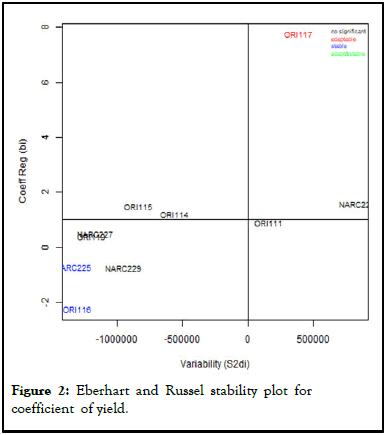
Figure 2: Eberhart and Russel stability plot for coefficient of yield.
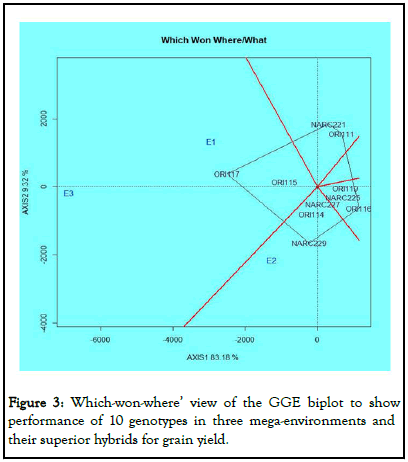
Figure 3: Which-won-where’ view of the GGE biplot to show performance of 10 genotypes in three mega-environments and their superior hybrids for grain yield.
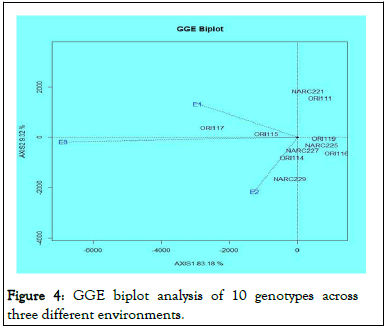
Figure 4: GGE biplot analysis of 10 genotypes across three different environments.
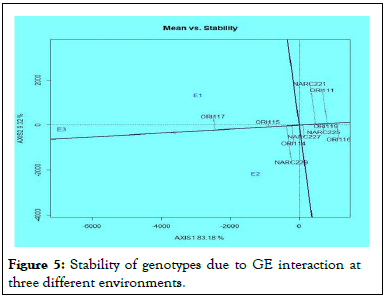
Figure 5: Stability of genotypes due to GE interaction at three different environments.
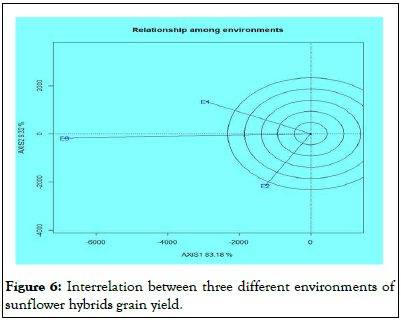
Figure 6: Interrelation between three different environments of sunflower hybrids grain yield.
Since the inception of breeding, exorbitant researchers studied the effect of environment on sunflower genotypes. In present experiment, ten sunflower hybrids were examined for stability analysis across three consecutive environments. Key important factors of G × E, such as analysis of yield stability, combined analysis of variances for sunflower grain yield, analysis of genotype × environment interaction, the best fit genotype of a particular environment, relationship among environment, mean yield influence by environments, and comparison of stability indices were examined. Yalcin, et al., investigated 3 commercial sunflower hybrids at two different environmental condition of Trakya agricultural research institute field in Edirne Turkey, observed varied seed yield of sunflower genotypes directly associated with multiple environments. Our results are in line with findings of Yalcin, et al., in present experiment, significant amount of variation (20%) for grain yield of 10 sunflower hybrids was incremented by three consecutive environment’s associated factors at temperate region of national agriculture research center Islamabad. Such experimental findings were in confirmation with findings of who also found majority of variability due to environmental influences on grain yield of 24 sunflower genotypes at 3 different locations of two environments 2013 and 2014 in Serbia. Optimum temperature and different patterns of rain fall were creating conducible environmental condition for better adaptation and stability of sunflower hybrids for grain yield. Similarly, impact of rainfall on sunflower genotypes was also observed by Adugna and Labuschange and reported significant variation via mean annual precipitation. The unstable yield of sunflower hybrid is mainly due to changing patterns of rain fall as mention of environment such effect of precipitation was also experienced by Yeremenko et al., conducting an experiment comprised of 7 sunflower hybrids during 2013-2015. Amazingly, mentioned that no single variety performed outstanding during their entire experimental trial, however, a potential genotype EK01024-1-2 was performed better in multiple environments in comparison to other genotypes. In present experiment, no advance line, which out performed in all plat forms i.e. stable, adoptable and high performing, in contrary, genotype ORI-117 was adoptable and high yielding but not stable analyzed by Eberhart and Russel stability plot for coefficient of yield present in Figure 1. In present case, low stability may affect due to low average temperature, particularly in Environment (E2), which leads to chlorosis and causes low photosynthetic rate. While genotype NARC-225 and ORI-116 were stable across three different environments. This result was supported by Milan et al., that genotype stable in all environment should necessarily performed high yielding, because due to genotype environment interaction (G × E), and that is why it is principle pillar of breeders research to reduce such effect particularly.
The regression coefficient bi of NARC-225 was approximately equal to 1 and followed by ORI-116 with almost similar index value, similarly, Muhammad MY., observed same result by studying experiment of G × E interaction which was composed of 11 sunflower hybrids in five different environments in Sudan. Also, Becker and Leon were reported same effect that genotypes depicting bi values of unity gave mean performance to various environmental conditions? Defined that genotypes having value of regression coefficient unity (bi=1) gave excellent mean performance. Similarly, these genotypes also shows better acclimatization a cross different environments.
GGE biplot is useful statistical tool to visualize uniform stability, adoptability and high performing genotypes a cross different environments. Elucidating of genotypes main effect with addition of GE interaction were attributed by GGE biplot analysis which are not represented by additive main effects and multiplicative interaction. Especially it visualizes any crossover G × E interaction. It is recorded 216 different families in GGE plot in Pinus radiate genotypes grown at five different locations. It is dentified adaptive and stable cotton cultivars across six environments using GGE biplot analysis. In present experiment, we studied mean grain yield data of all 10 genotypes of sunflower for 3 environments were used to construct GE biplot. The “which-won-where/what” plot represented higher mean performance of ORI-117 and ORI-115 at two environments E1 and E3. Similarly, for environment E2 only best performing genotype was NARC-229 and highest yield were recorded for genotypes ORI-114 and NARC-227.
Evaluation of elite genotypes for screening and identification by “which won where/what” was described by by Yan and Hunt at single or multiple environments. Similarly, same model has also been used by Ding et al., and Ali et al., for screening of pine and cotton genotypes a cross different environments, respectively. Environmental comparison plot depicted resemblance among various environments such as E1, E2 and E3 which confessed with geographical proximity with reference to their climatic change [10,11].
Recent imbroglio of Genotype by Environment interaction (G × E) and its way forward remain the prime objectives of plant breeders to excel in consistence yield stability in sunflower. In Pakistan, sunflower is a marginal oilseeds crop and mostly grown in rain fed areas unlike wheat, rice sugarcane and cotton which are widely grown in irrigated plains of Punjab, Sindh and Khyber Pakhtunkhwa. Due to unprecedented drastic changes in climate and unpredictable precipitation pattern, sunflower yield has been immensely influenced leading to unstable production. Besides, the diverse agro-ecologies of the country do not permit farmers to rely on existing environment-responsive hybrids. For breeding new sunflower inbred lines, adaptation and yield stability must be considered as important trait. Therefore, we represented results from univariate and multivariate approaches quantifying genotype by environment interactions on seed yield. Genotypes i.e., ORI-114, NARC-227 and ORI-115 produced both above average yield and relatively remain consistent at different environments. Very interestingly genotype NARC-225 and ORI-116 was stable over all environments. These genotypes showed dynamic yield stability and adaptation across different environments in arid cool climate of Islamabad. It denotes presence of adaptable loci in these genotypes for adjusting fluctuation to external stimuli and phenology according to the agro ecological conditions. Indigenous plant breeders can develop new inbred lines by further improving these genotypes for yield and yield associated components and also other economically important traits.
This research is part of the agriculture linkages program ALP project titled “development of local sunflower hybrids and seed increase, funded by the Pakistan Agricultural Research Council (PARC) Islamabad. Special thanks to Mr. Ihsaan Ulla, and their team for efforts in carrying out the experiment at Oilseed Research Program (OSRP), Islamabad.
[Crossref] [Google Scholar] [PubMed]
[Crossref] [Google Scholar] [PubMed]
Citation: Khan K, Ullah I, Khurshid H, Yazdan F, Jhanzaib M, Mukhtiar A, et al. (2023) Temporal Climatic Comparison of Various Narc Sunflower Hybrids Based on Their Yield Stability. J Plant Biochem Physiol. 11:281.
Received: 25-Jul-2023, Manuscript No. JPBP-23-21637; Editor assigned: 27-Jul-2023, Pre QC No. JPBP-23-21637 (PQ); Reviewed: 10-Aug-2023, QC No. JPBP-23-21637; Revised: 17-Aug-2023, Manuscript No. JPBP-23-21637 (R); Published: 24-Aug-2023 , DOI: 10.35248/2329-9029.23.11.281
Copyright: © 2023 Khan K, et al. This is an open-access article distributed under the terms of the Creative Commons Attribution License, which permits unrestricted use, distribution, and reproduction in any medium, provided the original author and source are credited